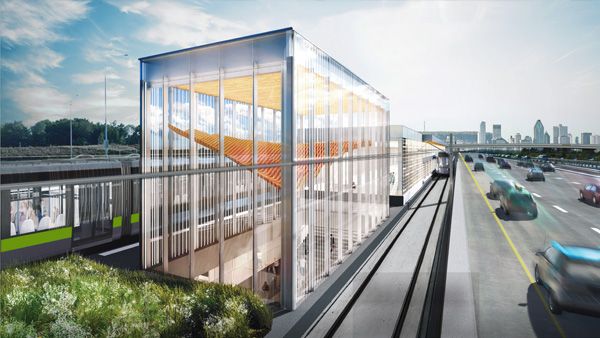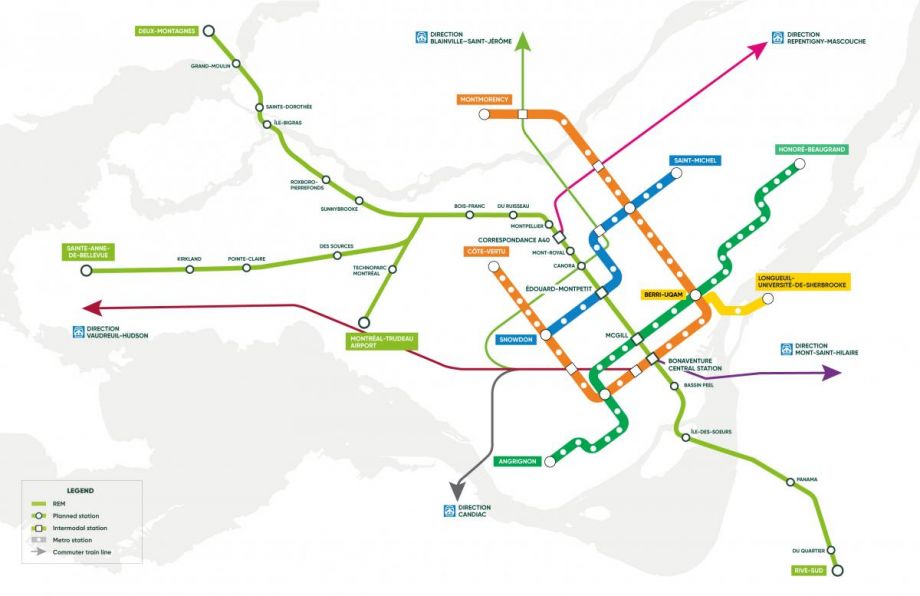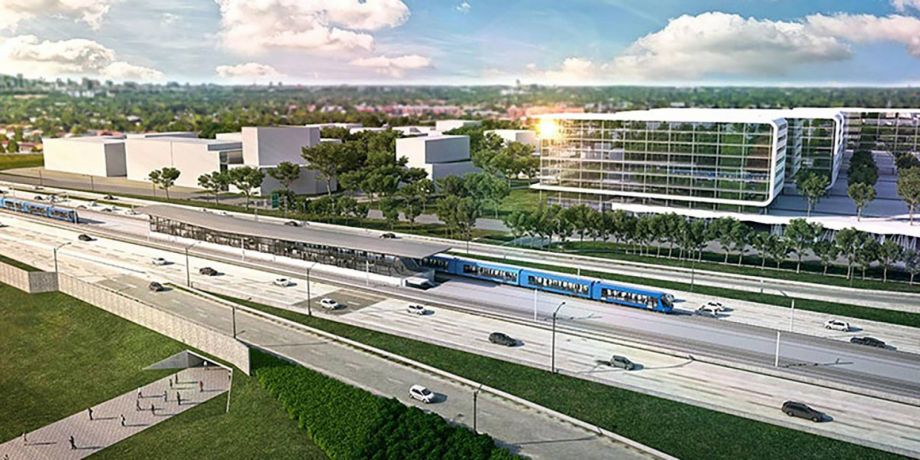Are You A Vanguard? Applications Now Open
Rendering of the Réseau express métropolitain (REM)
This is your first of three free stories this month. Become a free or sustaining member to read unlimited articles, webinars and ebooks.
Become A MemberIt sounds like the kind of project cities don’t dare to dream of anymore: a massive new transportation network on par with the great mass transit buildouts of the 20th century.
The Réseau express métropolitain (REM), French for metropolitan express network, is slated to be the largest investment in Greater Montreal’s public transit in 50 years. Projected to be completed within four years, the fully-automated light-rail system rivals the creation of the city’s subway, the Métro, in both size and impact. It is among the largest public transit projects in Canadian history and is intended to demonstrate new alternative funding methods for infrastructural mega-projects — in this instance, a “public-public” partnership.
Once completed, the REM will ferry passengers between the city’s international airport and the train station located near the core of the central business district. It will carry commuters from rapidly growing off-island suburbs over the new Champlain Bridge — designed with light rail in mind — and connect new urban neighborhoods currently lacking in public transit access. Further still, the REM will reach into the city’s sprawling western suburbs to provide a long-awaited improvement to the current cumbersome and delay-prone commuter rail network.
When all is said and done, say its promoters, the REM promises to be the world’s fourth largest fully-automated light-rail system, offering competitive travel times, full integration with the city’s existing public transit systems, universal access and climate-controlled multi-modal transit stations. More than just a new railway network, it is being sold as a mechanism to shift the region’s transportation gestalt toward public transit and to foster new transit-oriented developments within Greater Montreal.
Why, then, are environmentalists, transit lobbyists, architects, urban planners, researchers and the public consultation office highly critical — if not outright opposed — to a project that has so much potential? Why is there strong opposition to a major investment in public transit in a city that regularly ranks third in North America, after New York City and Mexico City, for daily rapid transit ridership?
Critics charge that the REM is a backdoor to the privatization of public transit in its own right, and by privatizing key public transit infrastructure, in the long run it will limit the potential to expand other systems, such as the city’s Métro or commuter rail. Moreover, the project’s developer has chosen a route design that would be highly favorable to its own real estate holdings and would further support suburban residential construction, in which it is a major investor. This has led some to condemn the project as a real estate venture masquerading as a public transit project. To top it all off, though a considerable amount of public money will be used as start-up capital, contractually obligated annual returns will essentially remain in private hands.
More broadly, whether the REM is even a good public transit system remains an open question — the provincial environmental assessment board has indicated it isn’t convinced that the REM would deliver on any of its promised benefits.

These problems can be traced back to the way the REM was conceived, planned and approved. It is a transit system being imposed on the city of Montreal by the provincial government and its pension fund. It was not proposed by the city’s public transit agency, nor the provincial transit agency responsible for organizing public transit throughout the metropolitan region. There was never any comparative analysis with other transit systems, such as a tram or an extension of the Métro. And the CAD$3 billion (US$2.34 billion) in public money committed to the REM — just under half the project’s total cost — is not available to spend on any other transit project.
“The REM is privatized infrastructure that is both expensive and poorly planned,” says Anton Dubrau, a transit analyst who submitted a 100-page analysis of the REM project to the provincial environmental public consultation board. Like many of the REM’s critics, Dubrau contends that the project “is debt by another name,” and that its supposedly innovative funding scheme is deeply problematic. Yet the project is going forward, leaving advocates dismayed that the city’s marquee transit project is the latest example of a broken planning process that has plagued Montreal for decades.
The origins of the REM lie in an agreement signed in 2015 between the government of Quebec and the Caisse de dépôt et placement du Québec (CDPQ), an institutional investor that manages Quebec’s pension plans and insurance programs. The agreement stipulates that the CDPQ seek new methods of financing infrastructure that are in line with its mandate to provide a strong return on investment for the pension fund. In theory, it’s a win-win situation: The provincial pension plan (as well as several public sector pension plans) gets a boost, and the public itself gets a useful piece of infrastructure to improve their daily lives.
The REM project is the preeminent example of this effort. On February 8, 2018, the CDPQ confirmed that construction of the 26-station REM network would begin as soon as possible with a delivery date expected in 2021 or 2022. The cost of the project would be shouldered approximately 50-50 — around half would be paid by the federal and provincial governments, and the other half financed through the CDPQ. This shared cost burden is one of the REM’s key selling points. With about half of the estimated CAD$6.3 billion (US$4.75 billion) total cost to be covered by the pension fund, half of the capital costs will be off government books. In essence, half the project’s “risk” is shouldered by a non-taxpayer supported entity.
A new organization, CDPQ Infra, wholly owned and operated by the CDPQ, would be tasked with this new mission of infrastructure development. A little more than a year after being created, this entity unveiled its plans for the REM, the first project in which it would invest — a project CDPQ Infra itself had created. Jean-Marc Arbaud, deputy managing director of CDPQ Infra, says that the current government of Quebec requested that CDPQ Infra come up with a way to unite several distinct and unrealized public transit development projects for the region of Greater Montreal into a single, fully automated system using as much existing infrastructure as possible to minimize capital costs.
But according to REM’s critics, it’s not that simple. For one thing, under the current arrangement, the government and the CDPQ are joint shareholders in the REM project. But they’re not equal shareholders. The CDPQ maintains majority control of the shares. “They will receive preferred dividends; profits will go to the CDPQ until between eight and 10 percent annual return is achieved,” says Dubrau. Only after that will profit go to the government, which is contributing roughly half the total cost. All dividends will go to CDPQ Infra up to their target dividend of 8 percent.
Dubrau believes that after the CDPQ takes its cut of the profits, there won’t be enough left over to cover the accumulated interest, so the government won’t make back the money it put in. According to his analysis, this would be true even at the preferred borrowing rates normally accorded to government. “So who’s picking up that slack?” asks Dubrau. “I believe it will be the taxpayers.”
Remarkably, the Urban Development Institute of Quebec, a non-profit organization calling itself “the voice of Quebec’s commercial real estate industry since 1987,” and which counts the CDPQ’s real estate arm (Ivanhoe-Cambridge) as among its chief partners, issued a warning in June 2017 that one aspect of the REM’s financing could potentially undermine the project’s viability. The issue concerns fees that will be imposed on properties within a given radius of each station, which the institute argues might have the adverse effect of pushing real estate developers to build outside the fee zone of each station. This would undermine the transit-oriented development the REM was supposed to encourage.
In addition, the CDPQ is being offered, apparently free of charge, existing publicly owned infrastructure — namely, the Mount Royal Tunnel, which houses a high-traffic commuter rail line under the city’s highest peak, Mount Royal. Both the Mount Royal Tunnel and the Deux-Montagnes rail line (the city’s busiest commuter line) were, up until quite recently, owned and operated by Canadian National Railways, the formerly public corporation privatized by current CDPQ President and CEO Michael Sabia. Quebec taxpayers, through the Montreal area regional transit agency, bought Mount Royal Tunnel from Canadian National just three years ago at a cost of CAD$97 million ($75 million U.S.), though it’s so far unclear whether the CDPQ will have to buy this infrastructure from the Quebec government. (The CDPQ has said they will pay “market value” for the infrastructure.)

Map of Montreal's mass transit systems and the REM's planned route, shown in light green
“Under this arrangement, the CDPQ intends to only operate the REM in the Mount Royal Tunnel,” says Dubrau, “meaning commuters who used to enjoy direct access to the city center will now have to transfer onto the REM before entering the tunnel.”
Dedicating the tunnel purely to REM train traffic also means that it won’t be able to accommodate high-speed rail, as has been proposed to link Windsor and Quebec City (the Canadian equivalent of the Boston-Washington corridor). According to Arbaud, it would be “impossible” to run different kinds of trains through the Mount Royal Tunnel, though he conceded the feasibility of this had not been studied.
According to watchdog group Trainsparence, the REM will monopolize both the tunnel and the most-used commuter rail line in Greater Montreal, and prevent several more rail lines from directly accessing the city center. In an opinion piece published by Le Journal de Montréal, prominent architect and urban conservationist Michael Fish indicated that the loss of the Mount Royal Tunnel to the REM would mean building a whole new train station for any future high-speed rail project, with an estimated billion-dollar cost. What’s worse, it would be unlikely such a station could even be built anywhere near downtown Montreal.
“The REM cuts long-term transit development off at the knees,” says Dubrau.
It also seems like the REM will be competing directly with established public transit services in Montreal. According to a February 2017 investment forecasting report, more than 90 percent of the REM’s users are expected to be existing transit users switching to the new system. In other words, the REM is primarily designed to replace existing transit systems (such as bus and commuter rail service) rather than adding new capacity to the city’s transit cocktail. According to CDPQ-Infra spokesperson Jean-Vincent Lacroix, once the REM is operational and the “adoption curve” period has passed, the system’s projected daily ridership will be 170,000. (For comparison, the city’s bus and subway system averages two million trips per day.) However, if 90 percent of this figure is current transit users, it doesn’t represent a very large net increase in daily ridership.
The political promoters of the project don’t seem to fully grasp these complications. For instance, Canadian Prime Minister Justin Trudeau has endorsed the Windsor-Quebec City high-speed rail line as well as a CAD$1.28 billion (US$1 billion) subsidy for the REM project, despite the REM complicating plans for high-speed rail. The confusion may stem from the project’s general lack of coordination. VIA Rail, Canada’s equivalent to Amtrak, and Montreal’s public transit agency were both left out of the discussions.
Canadian politicians these days are all about “innovative” transit solutions. The prime minister has indicated he believes a hyperloop could be a viable alternative to high-speed rail. The premier of Quebec, for his part, would like to build a monorail system to cover the 270 kilometer distance between the province’s two largest cities. And Montreal’s new mayor, Valérie Plante, campaigned successfully on building an entirely new subway line without any clear indication how it would be paid for.
The enthusiasm for exciting — if not entirely practical — new transit systems is in some ways an overcorrection to the disinvestment trends of the last several decades. Public transit development in Montreal peaked in the 1960s, ’70s and ’80s, before control over planning and financing such projects was transferred from the city’s mayor to the provincial government. Quebec instituted a moratorium on new subway construction, and several other marquee projects. Plans for an extension of light-rail access to the southern suburbs, a rail connection between the city center and the airport, a new commuter rail line to suburbs west of the city, and an extension of the Métro to eastern suburbs never made it past the drafting table.
Now those years of underinvestment are catching up with the city. “According to the provincial transport ministry, Montreal’s roadways are at capacity, and if you use the Métro you know it seems to be at capacity every day at rush hour,” says Montreal City Councillor Craig Sauvé. “Our opinion is that the REM is necessary, that it has the potential to do a lot of good, but we also have some serious criticisms.”
No political party in Montreal, Quebec City or Ottawa has so far come out against the REM — perhaps a sign of the times in which we’re living. In Sauvé’s estimation, it isn’t politically wise to be seen as anti-transit in Canada today. While the inclination toward transit is admirable, it can lead politicians to blindly support projects of questionable worth. When Jean-François Lisée, leader of Quebec’s opposition party, the Parti Québécois, asked whether the REM might require considerable government subsidies, the ruling Quebec Liberal Party voted against forming a commission to find out.
One of the REM’s most critical voices so far has been the provincial agency assigned to conduct public consultations on matters relating to the environment. The Bureau d’audiences publiques sur l’environnement (BAPE) is a neutral government agency reporting to the provincial environment ministry. It conducted public consultations in and around Montreal throughout 2016.
Its conclusions from those consultations, made public in January 2017, were explicit: It could not support the REM project as presented to the public. It cited a lack of financial transparency, including basic information pertaining to fares; the monopolization of crucial, publicly-owned railway infrastructure; and the likelihood that the REM could exacerbate congestion on the city’s Métro system while doing very little to accomplish public transit ridership targets established for Greater Montreal. In reacting to the analysis, the provincial premier, the provincial transport minister and then mayor of Montreal Denis Coderre all indicated that BAPE had exceeded its mandate in studying the impacts of the REM, and that the project would go ahead anyway.

This kind of relentless forward thrust has characterized the project since its inception. There are pervasive doubts about whether the REM will improve public transit in the city or region, and it remains unclear whether the REM will provide a net gain for public finances. Moreover, there was no bidding process or competition. The entity that will be responsible for building and operating the REM (and determining how much it will cost) is the same entity that decided the REM was the only solution to Montreal’s mass transit problems.
Despite all these concerns, Sauvé believes the project will go forward.
“It’s a done deal,” he says. “As far as we’re concerned we’re getting this project whether we like it or not. We believe that the project can be adjusted and that strong leadership at City Hall can help make this project a success.”
Steven Guilbeault, one of the co-founders of Equiterre, a local nonprofit environmental organization, is more optimistic about the REM’s long-term viability. “In the nearly 25 years that I’ve been involved with Equiterre, never have I seen so many politicians so enthusiastic about public transit as they are right now with the REM,” he said. “It’s remarkable. For years, Quebec and Montreal were at odds on transit and transport issues, an urban-rural divide that didn’t lead anywhere. Now things seem genuinely different.”
Equiterre, along with the David Suzuki Foundation and Vivre en Ville, a public interest organization that advocates for the development of sustainable communities in Quebec, made their recommendations known to BAPE; the CDPQ followed up with adjustments in line with those recommendations.
They included more intermodal connections with the city’s existing mass transit systems (particularly the Métro) and the preservation of agricultural lands near one of the proposed suburban stations. Both of these adjustments have since been included in the CDPQ’s revised project design.
Guilbeault also points out that this isn’t entirely new territory for the CDPQ, which was one of the partners in developing Vancouver’s Canada Line, completed in advance of the 2010 Winter Olympics. Guilbeault describes the Canada Line as an exceptional success, and indeed, ridership has exceeded anticipated rates since it opened in 2009.
However, in Vancouver’s case, the Canada Line was conceived by the regional transit planning authority, TransLink. The CDPQ was part of a private consortium that included the primary contractor, SNC-Lavalin, a major Canadian engineering firm located in Montreal. In the case of Montreal’s REM, the CDPQ plays both the role of public financing agency and the project’s overall designer.
And the REM’s critics charge that the intermodal stations are actually a major flaw in the system’s design. The REM as designed will require suburban commuters (who currently have direct access to the city center via the Mount Royal Tunnel) to transfer onto the REM in order to get to their destinations. These transfers, they argue, will increase commuting times and decrease passenger comfort.
Though investing in transit is in the public interest, the CDPQ’s insistence that the Quebec government green-light the REM as soon as possible, in addition to a dismissive attitude on the part of elected officials towards citizens’ criticisms of the REM, are what concern the project’s critics the most.
After all, Montreal and Quebec have a long and depressing history of “white elephant” projects that have locked residents into exceptionally high taxes for decades. A failure to consult the public or experts is part of the problem. Projects tend to be driven by political consideration, leading to corruption, collusion, and fraud. Few have ever been prosecuted. Corruption has tainted nearly every major infrastructure project since the Olympic Stadium was constructed in the 1970s. Despite commissions and inquiries (and considerable sleuthing by Quebec’s journalists), there hasn’t been much in the way of progress. Many REM skeptics have pointed out that the CDPQ has major interests both in suburban property development as well as major property holdings in downtown Montreal, where two new REM stations will increase the size of Montreal’s underground city and the vast transport hub sprawling out from the city’s central train station.
To put things in perspective, Montreal’s two commuter and passenger rail stations are about a five minute walk from one another, and they in turn connect to four of the city’s busier Metro stations, all in a largely underground, climate-controlled environment. This is further connected to the city’s premier hotel (the Queen Elizabeth), the city’s iconic office complex (Place Ville-Marie), its tallest office tower (1000 de la Gauchetiere Ouest), its newest office tower (Place Manuvie), and the city’s major shopping malls, such as Place Montreal Trust and Centre Eaton. All of these buildings are owned by the real estate subsidiary of the CDPQ.
The financing of public transit has always come down to a matter of taxation for the greater good. Though the REM is being sold as a solution that will reduce government expenditures, it seems to some to simply be a means of shifting public money off public books and into the hands of competent, though entirely profit-driven interests. Whether actuaries make for good transit planners is something the people of Montreal will soon find out.

Taylor C. Noakes is a freelance journalist from Montreal who focuses on the intersection of history, architecture, urban planning and public policy. He once debated four former Canadian prime ministers simultaneously (and lost.)

20th Anniversary Solutions of the Year magazine